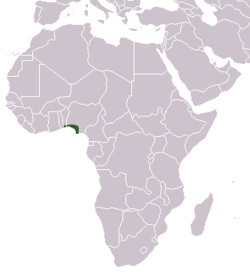Red-bellied monkey
| Red-bellied monkey | ||||||||||||
|---|---|---|---|---|---|---|---|---|---|---|---|---|

Red-bellied monkey ( Cercopithecus erythrogaster ) |
||||||||||||
| Systematics | ||||||||||||
|
||||||||||||
| Scientific name | ||||||||||||
| Cercopithecus erythrogaster | ||||||||||||
| Gray , 1866 |
The red-bellied monkey ( Cercopithecus erythrogaster ) is a primate species from the genus of the monkeys ( Cercopithecus ) within the family of the vervet monkeys (Cercopithecidae).
features
The fur of the red-bellied monkeys is predominantly dark in color, and under the face they have white-yellow whiskers-like hair. The face around the eyes is blue, the nose is colored white. The eponymous reddish-brown coloration of the breast and stomach is not always present, in some animals this area is gray. With a weight of 3.5 to 4.5 kilograms for males and 2 to 4 kilograms for females, these primates are among the smaller monkey species.
distribution and habitat
These animals live exclusively in a small area in southwestern Nigeria and southern Benin . Their habitat is rainforests, both primary and secondary forests . In Nigeria, their range affects the Okomu National Park and various forest reserves such as the two Ramsar protected areas in the Niger Delta on Apoi Creek and on the upper Orashi River .
Way of life
Red-bellied monkeys are diurnal tree dwellers and, like all monkeys, live together in groups, usually in small groups of around five animals, but sometimes up to 30 individuals can be found. The diet of these animals consists primarily of fruits, but they also eat insects and leaves.
threat
Intensive hunting due to its beautiful fur has brought the species to the brink of extinction, another factor is the destruction of its habitat through progressive deforestation and urban sprawl. The IUCN lists the species as endangered .
literature
- Thomas Geissmann : Comparative Primatology. Springer-Verlag, Berlin et al. 2003, ISBN 3-540-43645-6 .
Individual evidence
- ↑ Cercopithecus erythrogaster in the endangered Red List species the IUCN 2006 Posted by: T. Butynski & Members of the Primate Specialist Group, 2000. Retrieved on 11 May, 2006.
